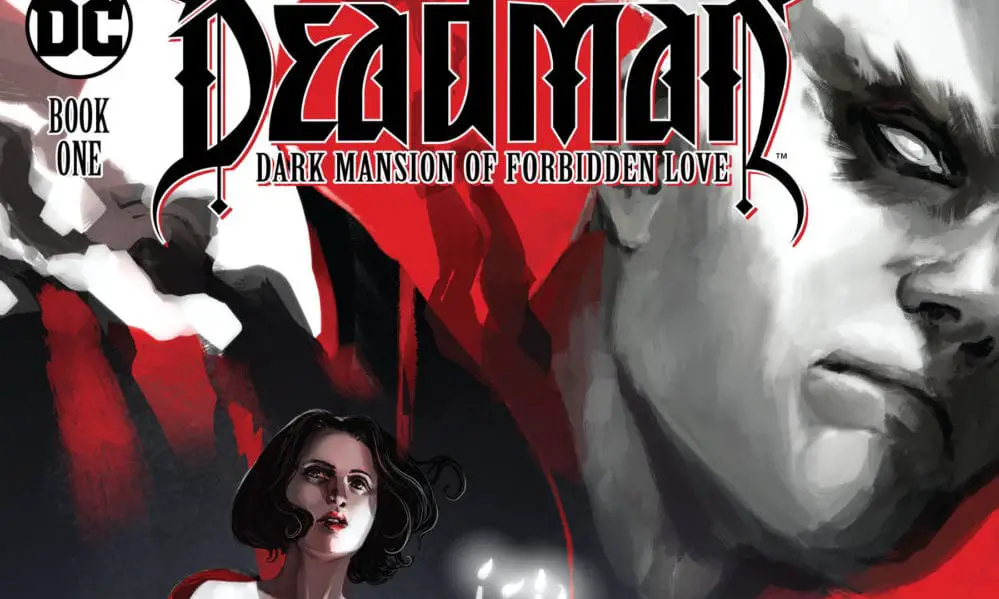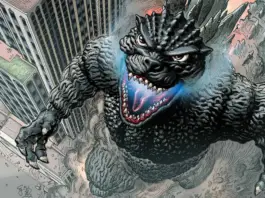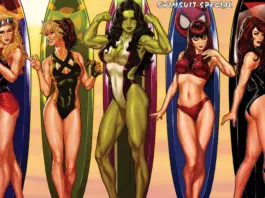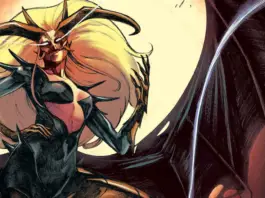Deadman: Dark Mansion of Forbidden Love, Issue 1
Deadman: Dark Mansion of Forbidden Love is a bimonthly three issue comic book miniseries in the DC universe whose first issue dropped this month, just in time for Halloween. Now, I’m the first to admit I’m a filthy casual when it comes to comics. (I’ve never picked up a Batman or Superman comic, and the only series I currently read is The Wicked +The Divine.) But as soon as I heard “gothic romance with a bisexual female protagonist” I was on board. Ghosts, a haunted house, creepy ambience, a dash of romance, a queer female protagonist who can see the dead, and a superhero that possesses people? Sign me tf up.
The Plot
A young woman, Berenice, and her boyfriend Nathan move into his ancestral home when his uncle dies. He’s finishing a novel, but he’s been getting headaches that make it difficult to work. Berenice spends a lot of time with Sam, and they’ve been growing closer since the move. Deadman is a dead superhero who can possess people and often helps to solve supernatural crises of the dead people variety. Berenice can see ghosts, and when Deadman learns of this, he recruits her to help him figure out who the ghostly woman haunting the house is, what the darkness is that’s been attacking them, and why he seems trapped in the house with only limited use of his powers.
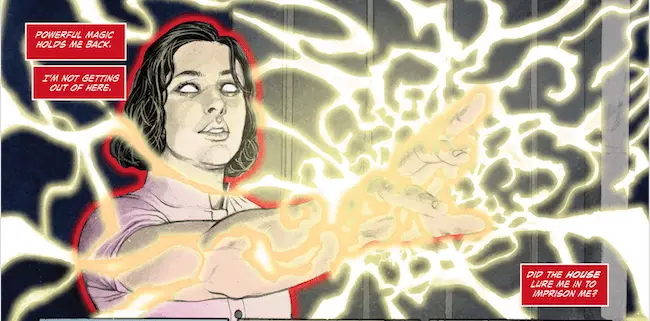
You’ve got everything a good gothic romance needs: a threatening mystery, an ancestral curse, a newly inherited mansion, and a ghost or two (one of whom happens to be the titular Deadman). You have the romance undergirding it all as well. The female protagonist has an established relationship with the reclusive owner of the house, but the main romance seems to be between her and Sam, the bright and friendly non-binary owner of the town’s antique shop. Add in a dead superhero to help solve the mystery, and you have all the makings of a good gothic superhero romance. I found the tale well-written and engaging, both true to genre and innovative when it comes to characters. I’m already champing at the bit for the next issued, which will be released in December (Happy Holidays to me!).
Though the ostensible hero of the story, Deadman comes second to Berenice. This is her story more than his. To better make that point, the issue begins with Berenice’s POV then shifts to Deadman’s about halfway through. Each perspective balances the other, and the story is richer for the variety. As a human being, Berenice’s perspective garners more empathy from the audience, drawing us in in a way that Deadman, the ghost of a long dead former trapeze artist, may not have been able to do. Not that he couldn’t, I like his character and would read the series if were only from his perspective. Nevertheless, Berenice’s struggle with her power to see ghosts, her relationships with Sam and Nathan, and her willingness to challenge Deadman’s approach to possessing people lends a humanity and pathos to the series that only heightens it’s interest.
I’ve seen other reviewers criticize the slow start to this series, as the primary confrontation does not occur until the last few pages. As this is issue one of a three part miniseries, one would expect more of a running start. On the other hand, Deadman is not the most popular or recent of DC superheroes either, so worldbuilding must needs be done. On top of that, a slow build fits within my understanding of the genre expectations for gothic romance. A slow, creeping sense of discomfort, of foreboding, with glimpses of the looming darkness culminating in a confrontation at the end of the issue works well in that regard. Gothic stories thrive on ambiance, which I think Deadman establishes well with the slower pace this issue.
Characters
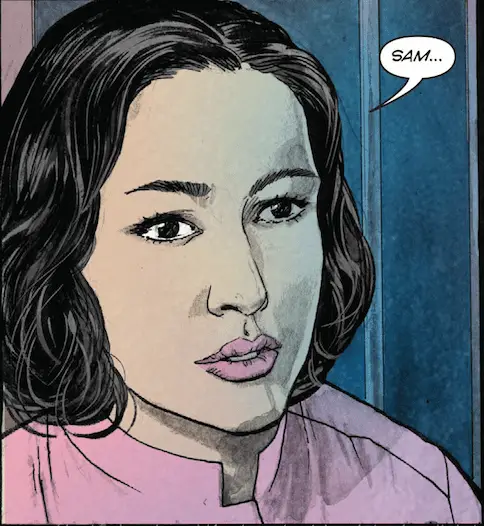 If the plot fits well with the genre of a gothic romance, the characters defy expectations. Unlike the comics put out in the 70s, the female protagonist is neither white nor a helpless damsel. Berenice is half-Korean and has already proven herself capable of holding her own against Deadman’s outdated views on consent (she tells him he oughtn’t to possess people without consent and under no circumstances will she give him hers). She’s smart, a bit stubborn, and clearly her ability to see ghosts weighs on her and her relationships with others, as she fears to tell them her abilities lest they reject her as a previous girlfriend had. Oh, did I mention she’s bi/pan? She is. She’s had one girlfriend we know of, a current boyfriend, and her new love interest is non-binary. She’s also chubby, another delightful bit of representation sorely lacking in much of DC’s superhero universe.
If the plot fits well with the genre of a gothic romance, the characters defy expectations. Unlike the comics put out in the 70s, the female protagonist is neither white nor a helpless damsel. Berenice is half-Korean and has already proven herself capable of holding her own against Deadman’s outdated views on consent (she tells him he oughtn’t to possess people without consent and under no circumstances will she give him hers). She’s smart, a bit stubborn, and clearly her ability to see ghosts weighs on her and her relationships with others, as she fears to tell them her abilities lest they reject her as a previous girlfriend had. Oh, did I mention she’s bi/pan? She is. She’s had one girlfriend we know of, a current boyfriend, and her new love interest is non-binary. She’s also chubby, another delightful bit of representation sorely lacking in much of DC’s superhero universe.
 Sam is not only non-binary, they’re also black. Friendly, supportive, and nurturing, Same balances out Berenice’s anxiety and trepidation about the house. The first scene of them both in the car together evinces how genuinely Sam enjoys being with Berenice. The scenes about the Korean bowl Berenice picked out at the antique show (and subsequently broke) give us hints into the depth of their affection for Berenice. Sam seems like the kind of good person that Berenice needs in her life, someone who would support her through anything and provide a sense of calm and balance. (I like Sam a lot, okay?). At one point Deadman refers to Sam with she/her pronouns and Berenice corrects him in a way that feels both real and not-condescending to the audience. Deadman takes it with remarkable aplomb and switches readily to they/them.
Sam is not only non-binary, they’re also black. Friendly, supportive, and nurturing, Same balances out Berenice’s anxiety and trepidation about the house. The first scene of them both in the car together evinces how genuinely Sam enjoys being with Berenice. The scenes about the Korean bowl Berenice picked out at the antique show (and subsequently broke) give us hints into the depth of their affection for Berenice. Sam seems like the kind of good person that Berenice needs in her life, someone who would support her through anything and provide a sense of calm and balance. (I like Sam a lot, okay?). At one point Deadman refers to Sam with she/her pronouns and Berenice corrects him in a way that feels both real and not-condescending to the audience. Deadman takes it with remarkable aplomb and switches readily to they/them.
As far as Nathan goes, I can’t say much. He’s not on page enough to analyze fully. He seems a decent fellow. As a writer myself, I sympathize with his migraines and struggle to get his novel finished. No doubt he will be integral to the unraveling of the mystery, however. It’s his house and his ancestor haunting the place after all.
 As the current love interest for our female protagonist, I would have liked at least a teensy bit of back story for his relationship with Berenice: how they met, how long they’ve been dating, what state their relationship is currently in. As it stands, Berenice’s interest in Nathan feels a bit lopsided, and the growing attraction between Berenice and Sam can feel a bit stunted as a result. If, for example, they’ve only been dating a short time, Nathan’s neglect of Berenice since the move to his ancestral home and her feeling disconnected from him would be an even more natural than if they’d been dating for years. Moreover, as this is his home, I want to care about how the haunting affects him as well as how it affects the main protagonists. From this issue alone, you’re not likely to have an emotional attachment to Nathan.
As the current love interest for our female protagonist, I would have liked at least a teensy bit of back story for his relationship with Berenice: how they met, how long they’ve been dating, what state their relationship is currently in. As it stands, Berenice’s interest in Nathan feels a bit lopsided, and the growing attraction between Berenice and Sam can feel a bit stunted as a result. If, for example, they’ve only been dating a short time, Nathan’s neglect of Berenice since the move to his ancestral home and her feeling disconnected from him would be an even more natural than if they’d been dating for years. Moreover, as this is his home, I want to care about how the haunting affects him as well as how it affects the main protagonists. From this issue alone, you’re not likely to have an emotional attachment to Nathan.
As I mentioned, the main romance seems to be between Berenice and Sam. Berenice’s boyfriend Nathan is on the pages for all of 3 seconds before being sidelined into his study to work on his novel. He fits the reclusive owner of the mystery house trope, but I get the feeling he’s not endgame. Sam and Berenice have stronger on-page chemistry and their interactions take precedence. They even have a ‘will they/won’t they’ kiss scene. Suffice to say, I ship Sam x Berenice and will be cheering for them in future issues.
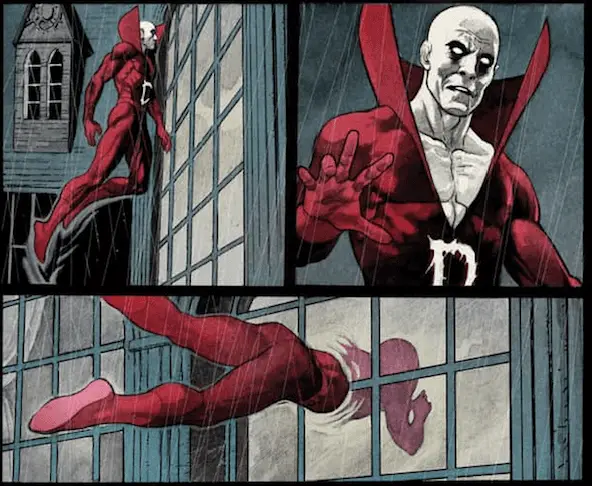 The final main character, Deadman, requires both the most and the least introduction, depending on your level of experience in the DC comic fandom. For those who know his backstory, very little needs explaining. For casuals like me, he’s a bit opaque as a superhero. A former trapeze artists in a circus, he was shot and killed and now lives as a ghost. People other than Berenice can neither see nor hear him, but he can possess living people to interact with the world. He can fly, pass through walls and other physical objects, and fight other spiritual energies as if they had mass. He has compassion for both the spirits trapped in the human world and the ones negatively effected by their hauntings, and seeks to help, even if he uses dubious means to do so (possession).
The final main character, Deadman, requires both the most and the least introduction, depending on your level of experience in the DC comic fandom. For those who know his backstory, very little needs explaining. For casuals like me, he’s a bit opaque as a superhero. A former trapeze artists in a circus, he was shot and killed and now lives as a ghost. People other than Berenice can neither see nor hear him, but he can possess living people to interact with the world. He can fly, pass through walls and other physical objects, and fight other spiritual energies as if they had mass. He has compassion for both the spirits trapped in the human world and the ones negatively effected by their hauntings, and seeks to help, even if he uses dubious means to do so (possession).
Artwork
This is the area where I admittedly have the least experience, as I’ve only recently started getting into comics. I do know that the visual and written aspects of comics ought to mutually support each other and enhance, rather than detract from, the reader’s experience. Ideally, writer, inker, colorist, and letterer work together to create a multi-dimensional story that blends the best of each of the skills of the creators. Since this is a new field of artistic critique for me, I’m bound to miss some things, but still, these are my impressions.
Overall the art leans heavily toward enhance rather than detract. With over 40 pages, the artist has a lot of work to do establishing both tone and new, unfamiliar characters and scenery, and he rises to the occasion. It’s a natural style—neither exaggerated or disproportionate—with a sense of realism about both the characters and how they react to the events as they unfold.

I like the palette quite a bit, especially how the tonal differences represent characters. Sam’s green and brown earth tones are soothing, a spark of comfort and life in the washed out and eerie blacks, greys, and blues of the mansion. Berenice’s bright pinks and purples are more vibrantly alive than Sam’s but also communicate more of a restless energy. There’s a touch of anxiety, as well as strength of personality and stubbornness with the contrasting purple and yellow. The curves of her body communicate a softness compared to the hard lines of the house.
Deadman’s red and white communicates both the blood, death, and his corpse-like nature as well as his role as the superhero. He’s dead, but not threatening like the inky, oozing blackness of the Darkness. It’s also an interesting blend of both old style Deadman and a new, modern take on the old character.
At times, the colorist can obscure some of the inking with his washed out tones, but it’s not a persistent problem. The paler colors might also feel a bit dated to readers who are used to the bright, bold colors used in digital comics, but they fit with the genre. This series is an homage to the 70s era DC gothic romances, so the faded colors seem par for the course, especially as they help facilitate the eerie, ominous ambience necessary for a good gothic tale about ghosts and haunted mansions.
The letterer effectively communicates shifts in character with different typefaces and fonts, together with the colorist in the shift from Berenice’s thoughts in blue to Deadman’s thoughts in red. The creepy font for the Darkness is a bit stereotypical horror font, but I don’t mind. It feels like a headnod to the genre more than a unconscious, somewhat dated choice.
One of my few critiques is how the cover art does not entirely fit with the interior art. Part of it may be due to having a different illustrator for the cover art, one that may not have been on the same creative page as the rest of the team. It is also possible that it was intentional. This feels more like a deliberate homage to the genre and the kinds of covers you see on the 70s gothic romances than a miscommunication (you can see examples of the 70s cover art here). As a stand alone
piece of gothic art, it’s stunning and beautiful, but it may be slightly misleading with regard to the artwork in the interior. Nevertheless, I had no trouble transitioning to the difference in art style on the interior and the story soon drew me in.
Conclusion
Deadman: Dark Mansion of Forbidden Love, Issue 1 is a promising beginning to this series. For a comic with only three main characters, it has a startlingly diverse cast, both racially and with regard to gender and orientation. The artwork is beautiful and the creative team seems to be mostly on the same page regarding how style and text fit together to tell the story. If this is the kind of storytelling we can expect from comic books in the 21st century, I’m on board. Give me all the racially diverse LGBT protagonists. It’s a timely genre for the month of October, so pick it up if you like gothic romance and diversity.
If you have differences of opinions or corrections, I would be delighted to hear them, so take it to the comments!
Final Score
A solid 9.5/10, would highly recommend and will continue to read
Images courtesy of DC Comics
Deadman, Dark Mansion of Forbidden Love Credits
Writer: Sarah Vaughn
Illustrator: Lan Medina
Colorist: José Villarrubia
Cover: Stephanie Hans

